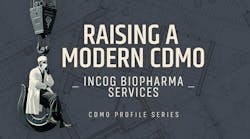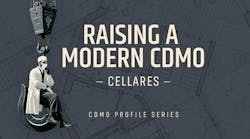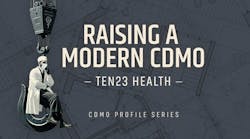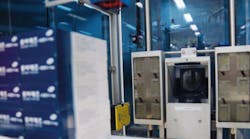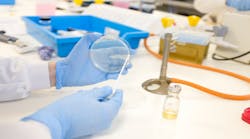Vaccines have never been a business for the faint of heart. Every facet of the business, from investment to GMP compliance, is fraught with risk. With prices and demand cycling up and down every few years, the market became so unattractive a few years ago that the number of U.S. flu vaccine suppliers dwindled to two. Then came last year’s H1N1 scare, a reminder that flu vaccine manufacturing is inefficient and variable, and the world unprepared for the next flu pandemic.
Novavax is betting on agility and innovation to help it hedge that risk and shore up global vaccine supplies. The company expects to meet the challenges of lower prices and expanding global demand with an insect-cell-based expression system, and an ultra-flexible manufacturing approach.
Most of the company’s management team comes from the world of traditional vaccines--CEO Dr. Rahul Singhvi formerly managed production of varicella vaccine at Merck, while chemical engineer James Robinson, Head of Technical and Quality Operations, spent over 20 years at sanofi pasteur, leading the industrial operations for the only domestic supplier of flu vaccine. But they’ve made a point of taking their company as far as possible from traditional vaccine manufacturing. Their ultimate goal is to license their technology to partners around the world, to ease the global shortage of vaccine. In October, they broke ground in India for a facility being built by their local partner, Cadila, while the following month, Xcellerex began contract production of H1N1 vaccine for Mexico, using Novavax technology.
Novavax is using the Baculovirus Expression Vector System, in which insect cells are cultured and infected with recombinant baculovirus. These cells produce three proteins, hemagglutinin (HA), neuramidase (NA) and matrix protein (M), which form virus-like particles (VLPs) that would offer protection against flu. The company expects to take its VLP-based seasonal flu vaccine into Phase III testing as early as next Fall. Immunogenicity testing is underway in pahse 2 studies, and the company’s scientists project the vaccine to offer special advantage to those over 50 with compromised immunity.
Yields have been shown the expression system be up to 20 times higher (in terms of grams of HA protein per volume) than for traditional methods, while a manufacturing process based on enclosed single-use equipment and downstream separation based on simulated moving bed chromatography, would allow manufacturing plants to be brought onstream in less than a year.
The company built a pilot plant in Rockville, Maryland, last year, at a cost of $5 million and in four months, a fraction of the cost and time required for traditional facilities. A conceptual design for a 75M dose per year plant has been developed for a projected $40M budget. It is now working with partners in India and Spain, and with technology partners that include Xcellerex, GE Healthcare and Tarpon Biosystems to achieve its vision of a single manufacturing process, validated once but replicated around the world.
VP James Robinson recently discussed the company, its plans and strategy.
PhM: What brought you to Novavax?
JR: It was one of those opportunities that only come once in a career. The technology was compelling, but one of the greatest attractions was the opportunity to work with Dr. Gale Smith, who co-invented the BEVS expression system while he was a graduate student in Max Summer’s lab at Texas A&M. I had an opportunity to work with him when I was at sanofi and he was at Protein Sciences Corp. At Novavax, I saw the possibility of taking something that he had invented 25 years ago and applying it to a vaccine that could be used around the world.
PhM: Besides its yield improvement, what else is significant about BEVS?
JR: The nice thing about this expression system is that you’re not actually growing the flu virus, so nobody can catch the virus from working in the production process, and nobody needs to be immunized. It’s a baculovirus itself, essentially a recombinant for of the biological pesticide that we already spray all over our trees and eat in our salads, so it’s very safe to work with. But it’s also a very flexible expression system, and has been used to synthesize over 100 proteins so far.
PhM: Are any other companies working with this expression system?
JR: A number of vaccines are currently being licensed based on baculovirus expression systems: For example, Cervarix, a cervical cancer vaccine developed by GSK, has been licensed in Europe (and now in the U.S.). It uses a different cell line from the one we are using, but the same type of expression system. As GSK and other companies blaze a trail, from a regulatory perspective, it opens up more possibilities for us.
I’m not sure why this whole approval process should take 25 years (the system has been around that long), but it does take time for people to be comfortable and certain that they understand the risks and benefits of a new cell line.
PhM: Are there any technical issues entailed in using this cell line that you wouldn’t run into with traditional systems?
JR: There are published guidelines for using new cell lines, but they are essentially written for mammalian cells. Insects don’t harbor mammalian viruses, so a lot of the guidance that has been written isn’t really relevant for insect cells.
Although insects have viruses, they don’t tend to infect mammalian cell lines, so you don’t risk having some latent virus in your product that could then infect, instead of protect, people. Even though the risk of adventitious viruses is very low with mammalian cells, it still exists, so a great deal of testing is required before you can get them approved.
Some companies have reportedly spent millions of dollars getting lines licensed and through all the regulatory authorities. Carrying on all the work required is a big undertaking for a small company like ours, even when the co-inventor is on your team. Especially since the system is novel, you need to convince people that there is no unknown safety risk.
.
PhM: Has FDA weighed in on insect cell expression?
JR: FDA has not yet licensed an insect cell-based product. One of the complications with Cervarix is that it uses a non-aluminum-based adjuvant. The U.S. has not approved non-aluminum-based adjuvants for vaccines, so the European vaccine isn’t approved in the US.
FDA reviewed our files because we’re in the clinic in Phase I and II with a number of products. They seem to be more comfortable with insect cell systems and cell lines because we were not the first and they’ve seen enough clinical data from other studies.
There are differences to our process: GSK used Hi5 cells to make HPV protein VLPs and Protein Sciences use the SF9 cell line to make the HA, where we make three proteins to form a particle. But they’ve also done a lot of safety testing. Once theirs is approved, it helps us quite a bit.
Sometimes it’s good to be second or third.
PhM: What are your plans for the facility in Rockville?
JR: We have purchased equipment to scale up to 1000 L, and, ultimately, may double that figure. Our Phase III studies could happen next year, so we need to have our process finalized before that point.
This 1000- or 2000-L process/facility would be able to support and gain us market share over a few years of marketing. Even with a product that is different from others, the vaccine market is a very competitive market, with long-term entrenched players and customer loyalty.
We could produce 10-20 million doses of trivalent influenza (the normal annual flu shot) in that facility, which would allow us to compete until we build a larger facility.
What has sped us up a bit is our international relationships. A number of countries don’t have domestic vaccine supplies and have had difficulties getting vaccines during pandemic flu outbreaks.
We now have the opportunity to work with governments and local players, to get a facility in place and to advance technology overall.
The first such alliance is a joint venture in India with Cadila Pharmaceutical Ltd. They currently have a pharmaceutical plant there but our venture will set up a biotech division.
We’ve already begun to put capacity in place within their existing walls, while they design their long-term, ultimate facility. We are also discussing with the Indian government the possibility of making some H1N1 product locally, using our technology and Xcellerex reactors, and the same equipment that we’d use in the US.
Meanwhile, in Europe, we’ve are in the final stages of licensing our technology to Rovi, a biopharmaceutical company in Spain that has a good collaborative relationship with the government, which would provide loans to support a facility, and tech transfer and do clinical studies in Europe.
Through our U.S. studies, Rovi’s European studies and Cadila’s studies in India, we would be able to build a nice large clinical file in the U.S., Europe and India. This would be useful in proving our process, and enabling us to license it around the world.
However, these global relationships have put more pressure on us to quickly lock down our process. We plan to build the same facility in three places, using identical equipment and process, even the same source of raw materials so that each facility is making exactly the same product. This way, clinical studies will all be comparable and can be put into one file. The simplicity of our process would allow us to do this.
PhM: What technologies are you using in this facility?
JR: We’re using Xcellerex’s disposable bioreactor and FlexFactory, which is essentially a small cleanroom that goes around each piece of equipment, separating processes that would normally have to be in separate rooms so that they can go into one room. This makes for a much smaller facility requiring fewer people and having better process control. The FlexFactory goes around all unit operations. We’re also using Xcellerex’s bioreactors and some of their mixing technologies.
After the initial production of VLP’s, we go through two filtration processes, using disposable hollow-fiber filters that are supplied by GE Healthcare. We worked with GE for some time to develop both filtration and chromatography processes.
Downstream, we’ve developed a simulated moving bed (SMB) filtration and chromatography separation system, using technology from Tarpon Biosystems Inc., which further reduces our cost of goods and allows us to shrink the process.
It also reduces the amount of resin and buffer that we use. Since chromatography resin accounts for 40% of our production costs, reducing requirements further reduces our cost of goods. Not only does their process improve speed and efficiency, it helps us save money.
After each batch, using Tarpon’s system, we consume all the useful life of the resin so the separation process essentially becomes disposable. Generally, chromatography is such an expensive process that one would never consider disposing of the resin after only one batch. With Tarpon’s process, you use many small columns many times, so you actually do use the resin’s entire useful life within a batch.
PhM: How are you automating this process?
JR: Xcellerex is also a CRO and CMO and has developed own internal systems for process control, automation and quality. With FlexFactory, we gain all their internal expertise and don’t have to develop our own expertise in automation and engineering.
A lot of people like to invent their own solutions and make their facility unique. The downside is that you’re always revising and retrofitting. By working with Xcellerex, we can use their platform and tie in other unit operations.
PhM: Can you share any data on savings from your plant design?
JR: We brought our greenfield Rockville facility on line in four months for $5 million. A production facility of 75M doses per season would coust an estimated $40M. By comparison, Sanofi has built an egg-based facility in the U.S. that will process 600,000 eggs per day to make 100 million doses per year. It will reportedly cost $150 million dollars, excluding utilities and supporting facilities. Novartis is building a $600-million greenfield plant with 50 million dose-per-year capacity in Holly Springs, N.C. So far, it has taken them over four years with costs reportedly approaching a billion dollars.
Working with Jacobs and Xcellerex, we have been able to further shrink our process and increase yields, and the process is much closer to finalization. Equipment can probably be half of what we originally estimated with Jacobs. Each day, costs seem to get lower and yields improve, so the facility could still be smaller and more productive for the same cost.
PhM: How will you handle validation?
JR: We are working to design a standard facility that we would build in other countries in collaboration with regional authorities. Our goal is to validate once and duplicate the facility many times. Every facility would use the same scale of bioreactor (using more than one if needed). What we want is a modular suite that has everything for the entire process in one room -one seed train, multiple production reactors and one purification train that allows for flexibility, using the same core technology.
PhM: Are you using batch processing exclusively at this point?
JR: We are working with batch processing exclusively, except for the chromatography process, which is almost running continuously, but we haven’t yet defined the start and end of a batch, so it’s not being continuously fed from something upstream.
The idea of continuous process is very interesting because it allows facilities to be even smaller because you don’t have the down time of cleaning between batches--if you can sustain the production process. I’m not sure at this time that our process could be adapted to continuous manufacturing. Further I don’t think it needs to in order to be very competitive with other technologies.
We have a more complex manufacturing system because we have multiple components. First, we need to grow insect cells to high density. In parallel, we grow viruses, then use the viruses to infect insect cells. After they’re infected, cells spend several days make more virus, then there’s a switch in the protein machinery where they stop making viruses and start making virus-like particles (VLPs).
If we could freeze that state and sustain the VLP production period and keep cells living for a very long time in transfected mode, then, in theory, the process could be run continuously.
But our process is already so productive that there is no reason to pursue this route. Perhaps we’d consider it with the second or third generation. There might be benefits, but also complications in how you manage it from a regulatory perspective, .particularly in ensuring the stability of transfection, and we haven’t even started to look at that.
Growing cells at high density, we use a process called bleed and feed, where we grow cells then take them off and grow them again, and keep taking them from one reactor. After a number of these cycles, the bags become more difficult to work with. Debris starts to collect and build up in some of the bag creases. Given these issues, it’s not worth considering continuous when the batch production process works so well.
PhM: What is your timeframe for all these projects?
JR: Our target is to move into Phase III efficacy studies next fall for seasonal flu. We have so far completed Phase I and II studies for H5N1 avian flu and completed Phase II in healthy adults for seasonal flu.
This fall, we will start studying seasonal flu in the elderly, defined as those 50 and over. Unfortunately, after age 50, the human immune system gets less productive. Today’s flu vaccines are estimated to be better than 70% efficacious in healthy adults with good immune systems, but for very young and very old, efficacy drops below 50%. Yet these groups of people are most at risk of infection and mortality from infection.
We believe that our vaccine not only produces antibody responses to hemagglutinin but gives you neuraminidase inhibiting antibody and cellular immunity, we believe that it will be more protective in elderly population, thus more efficacious than today’s egg based products. That study has started, and we’ll expect results soon.
It may turn out that our vaccine does not have confer a great advantage for the healthy adult but offers a strong advantage for immune compromised older populations.
PhM: How does your vaccine compare with commercial vaccines now on the market?
JR: We compare our vaccines today based on the same amount of HA going into a dose. Ours shows the same or better immunogenicity than licensed product, but the only thing we can really compare with licensed product is hemagglutinin, which is 40% of our vaccine…the remaining 60% is made up of neuraminidase and matrix proteins both of which are highly conserved in flu (theydon’t change much as the strains change from year to year). We believe this will contribute to protection, but there’s nothing to compare those two components to. In a way, we’re at a disadvantage because we can only measure the protective nature of one of our component proteins although we know historically that the other two will confer some level ofprotection.
In immunogenicity studies, which are how you license flu vaccines today, we are comparable. In efficacy we believe we will be superior, but those studies are costly and may be part of our initial licensing.
PhM: Are you planning to partner with any pharma companies?
JR: We’re a small biotech and there are ways to get vaccines licensed by following the immunogenicity model, which costs about $50 million, but, eventually you want to do both immunogenicity and efficacy.
If we were partnering with a big pharmaceutical company, they would likely want to invest in efficacy studies because positive results would differentiate the product, giving it a marketing advantage. The market is already crowded. Currently, there are six or seven licensed vaccines, and each year more and more vaccine is being left unused, which will eventually drive people to price cutting, driving market value down. This could cause the market to collapse so that nobody wants to be in it again. We’ve been there before.
In addition to the clinical study cost required to license a product, there is also a tremendous amount of work in product characterization, process and analytical validation, quality system development, and infrastructure development that would certainly benefit from the help of a larger Pharma partner or collaborator.
PhM: What are the operating costs relative to those of traditional vaccines?
JR: About a year ago, we had demonstrated the yields to be less expensive than egg-based flu, which is more productive than cell based. We believe that we will be the least expensive technology for flu vaccine manufacturing. However, it takes many million dollars to get licensed, so you have to consider what would be a fair rate of recovery of that investment. Then there’s the cost of setting up and underwriting all your capital, and the business risk involved. You need to put a lot of money in before anything comes out. Because of this its hard to say what the full cost of production will be relative to other established products, but we are confident it will be competitive.
It could also be a better product--we have yet to see results from clinical studies. We haven’t done a full-scale production study yet, but, if everything pans out, we will know the benefits of our vaccine as well as the cost.
PhM: What types of adjuvant are you evaluating?
JR: We’re not using adjuvants, although a lot of other companies use them to stretch antigen for pandemic, or to increase immune responses in older populations, One way to get a stronger and more cross-protected response is to use adjuvant, but it is also important to know if that higher response is specific to flu. The concern is what adjuvants do to human immune system after repeated use? Does it, after several years of using adjuvant, completely overwhelm the immune system to a point where it won’t respond anymore? Then you’d have a population that was once at risk that can’t be protected where at least you can give them some protection today. I am not an immunologist by any means; this should be heard as a layman representing his understanding of the issues that are discussed extensively in many global meetings on influenza vaccine development and testing.
This is really a concern to FDA. Regulators are concerned about the fallout if they approve anything that turns out to be unsafe, not just out of concern for individual patients, but because of the current anti-vaccine climate. If people stop believing in vaccines (there are already enough people that don’t get vaccinated who should. And that has caused outbreaks of measles and other diseases).and yet there are enough anti-vaccine people who are trying to reduce the uptake of vaccine, FDA doesn’t want to put out any vaccine out there that has an unacceptable level of risk.
In the event of pandemic, for example, if it were H5N1, where mortality is as high as 80% of people infected, one would take the risk and use with adjuvant because it would be more important to protect people from immediate danger.
H1N1 does not have high mortality (although it’s highly infectious), so perhaps FDA doesn’t think it’s worth the risk of putting anything on the market without adequate safety data. At this point, we do not plan to use adjuvant, although we do have adjuvant data in development, and our vaccine, when used with adjuvants, looks better than existing ones. We’ll reserve its use as a backup plan.
PhM: Over the years, we have heard of so many quality disasters at vaccine plants. Are there any potential QA/QC risks with your system?
JR: There’s a lot of inherent risk in making flu in eggs. I think the most recent experience in reacting to the H1N1 pandemic shows the need for improvement of the technology for making flu vaccines.
Chicken eggs are far from the ideal substrate for making a vaccine, but they have produced many billions of doses of vaccine that have protected many millions from disease while the new vaccines are being developed. Specific release tests for endotoxin and sterility are used to ensure that the egg-based process is safe and under control; but our process does not use a pathogenic organism (e.g., the flu virus)and it is free of biological contamination associated with eggs. Many of the risks with traditional systems are eliminated and others are minimized with the use of single-use systems. Of course we also have to manage the supply of our single-use components and suppliers to avoid an unplanned interruption in supply. However, managing those issues are expected to be a little less involved than managing the supply of 600,000 eggs per day.
In my professional life, I have probably made about 600 million doses of influenza vaccines in eggs; “the hard way”. This technology has many advantages in time, cost, expandability, and potentially protection, but it is expected to be safer, from both a manufacturing and a patient viewpoint as well.
